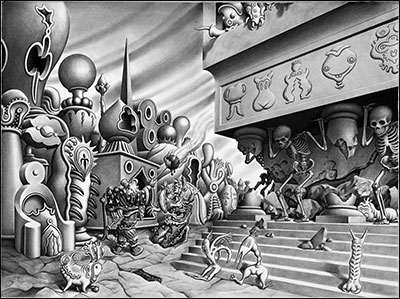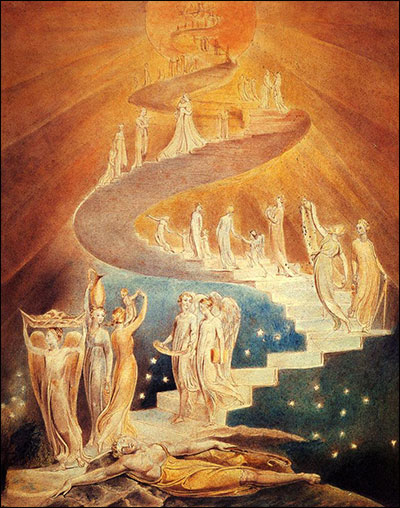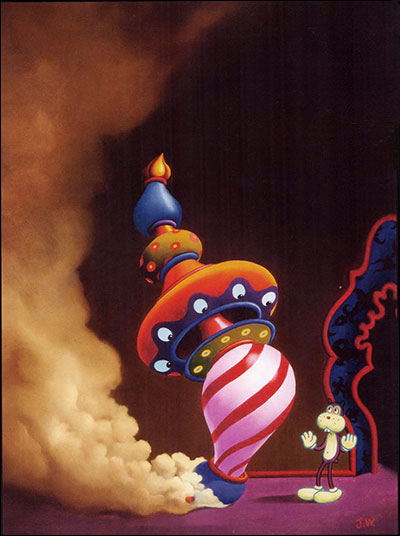A Tree Filled with Angels: The Visionary Worlds of Jim Woodring and William Blake
Please welcome the second guest post by artist and writer Eden Gallanter! Eden previously brought you an illustrated post on dancing, physics and Mannerstist painting titled The Tango, the Quark, and the Allegory of Love. In this post, Eden discusses the ways in which hallucinations have influenced the work of Jim Woodring and William Blake. Enjoy! – Nadya

Jim Woodring, “Divornum – or Life After Man”
Although Jim Woodring is a contemporary American cartoonist, fine artist, and writer with a strong cult following, and William Blake was a 19th Century English poet and painter who lived most of his life in poverty and obscurity, these two men shared a common source of artistic inspiration: both experienced visual hallucinations for the majority of their lives.

William Blake, Jacob’s Ladder
These visions (or apparitions) are clearly at the heart of both artists’ work, serving as gateways into another world that contains deep human truth and startling strangenesses. One account of Blake’s earliest visions, which remained full of the Christian iconography of 19th century England, describes the four-year-old Blake screaming for his parents upon seeing the face of God at the window. A few years later, he saw a “tree filled with angels,” and was saved from a thrashing by his father for telling a lie by the sympathetic intervention of his mother. Most of Blake’s hallucinations depicted the most beautiful and spiritual of the Christian themes. He also could see and speak to deceased friends, and saw angelic figures and other celestial beings mingled among the everyday ladies and gentlemen of England.

William Blake, Ghost of a Flea
Blake was considered to be a gentle madman by his contemporaries, and although some prominent writers regarded him with interest, his work was largely unrecognized during his lifetime. Upon encouragement by his friends, he painted some of the apparitions he saw, most famously his Ghost of a Flea. Blake’s lovely otherworldly visions, interpreted by him as divine inspiration, gave a confident shape to many socially deviant beliefs and practices. Blake had many ideas about religion that were frankly considered heretical (most notably his The Marriage of Heaven and Hell, which described a unified vision of the cosmos, where both satanic and angelic realms were a vitally important part of a holy and just world). Due to numerous references to the sanctity of romantic love and the necessity of its liberation from oppressive conventions such as duty and possession, Blake has been claimed as one of the forerunners of the Free Love movement in the 19th Century. His poetry is full of rejections of the Christian virtue of chastity, and his writing advocated the removal of bans on homosexuality, prostitution, adultery, and birth control. Blake is said to have lived a happy, quiet life: poor, obscure, and content simply in expressing his visions in his poetry and painting.
Jim Woodring has been intensely open about the “apparitions” he has experienced, and writes about them in his comics and other books. Perhaps due to our modern-day fascination with psychedelics, surrealism, and magic realism, Woodring is able to make his hallucinatory artwork and writing marketable, and has received international recognition for his intricate surrealist paintings and the dream-based comic series Frank. Frank, the hero of the comic, lives in a dream-like world that Woodring calls the Unifactor. As in the dream-worlds depicted in William Blake’s poems, paintings, and allegories, there is a distinct spiritual flavor to the Unifactor (beings that look like soft toy tops are called “angels” or “conditioned souls”), and indeed Woodring has come to subscribe to the spirituality of Vedanta, a sect of Hinduism which focuses on self-realization and ultimate reality.
Woodring describes his hallucinations as inventions of his own mind, while Blake understood his as divine visions of inspiration and a profound universal reality. Perhaps these seemingly opposite viewpoints are not so different: Woodring’s visions tended to be darker, more disturbing and terrifying, while Blake’s most often gave him a glorious view into a world of divine beauty and truth. Woodring’s art is recognized and rewarded during his life, while Blake passed his life in poverty. Both men’s visions gave them access to a world that was both alien and human, and provided the touchstone for their artistic expression, even if the results of those visions excluded or benefited them in their livelihoods.

William Blake, Elohim Creating Adam
Are all divine visions inventions of our own minds? Are our minds portals for celestial beings with an independent existence? The answer to these questions may be entirely beside the point. Visions are real to the visionary, and contain meaningful substance that the visionary may use to manifest wonderful and terrible things in his or her own life, things that a visionary artist is then able to share with others who do not necessarily share his vision. If an artist is a person who sees that which is invisible to most, all hallucinations are potential works of art, for which the artist may derive independent existence in the rational and emotional experiences of the beholders of his or her art.

Jim Woodring, Cover, FRANK #3
